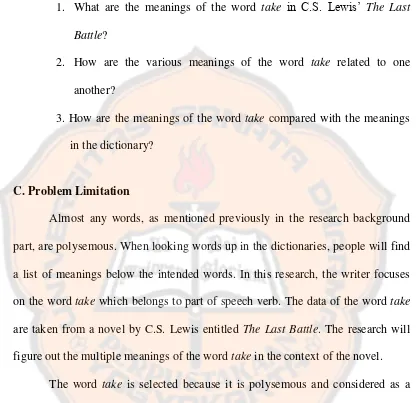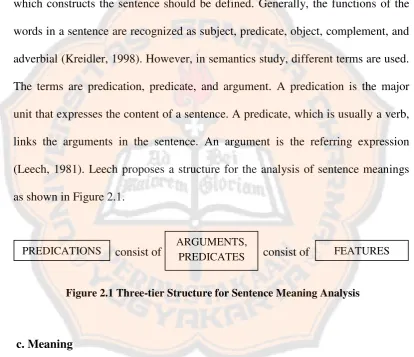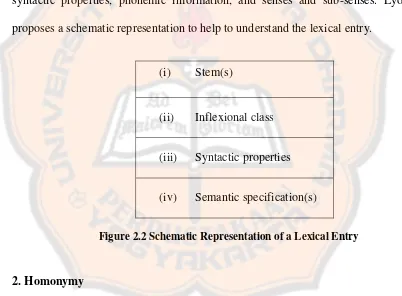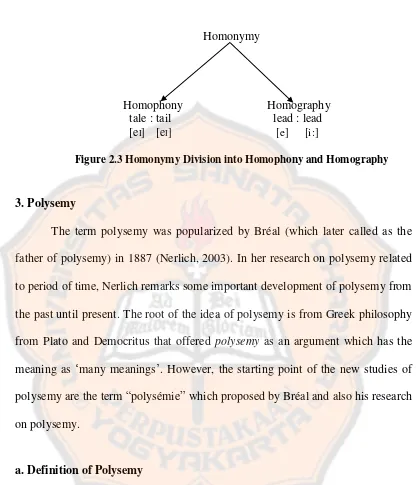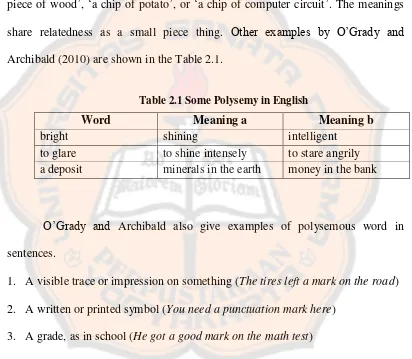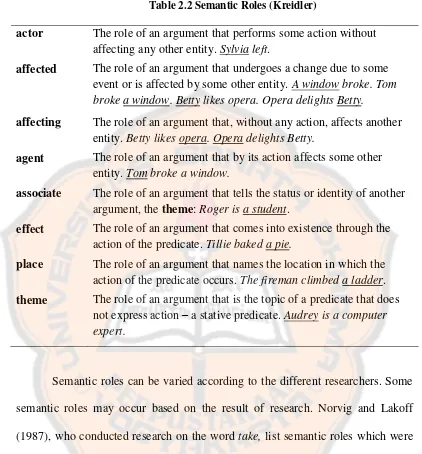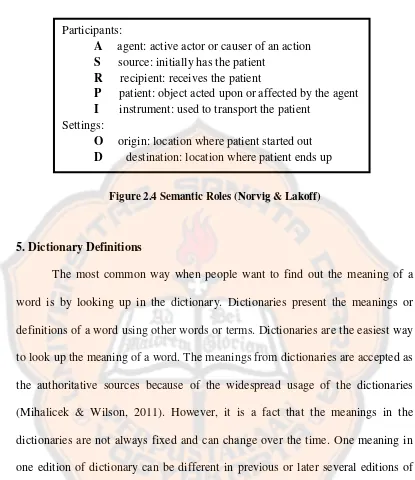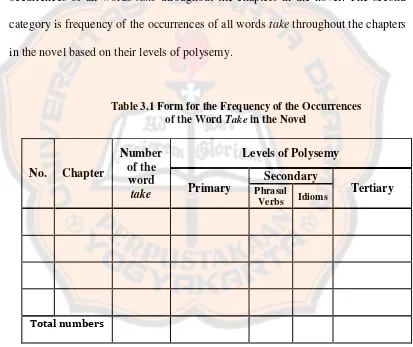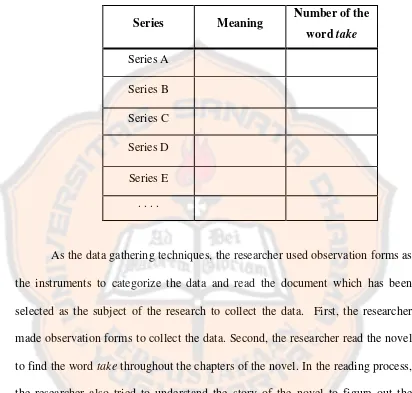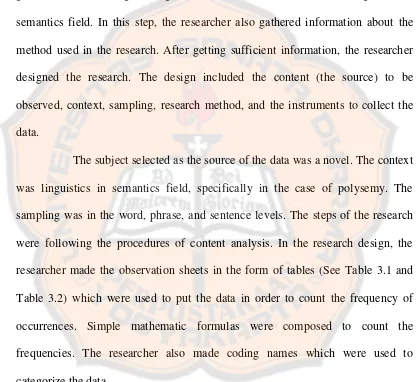UNDERSTANDING POLYSEMY PHENOMENON:
THE MEANINGS OF THE WORD TAKE
IN C.
S. LEWIS’
THE LAST BATTLE
A SARJANA PENDIDIKAN THESIS
Presented as Partial Fulfillment of the Requirements to Obtain the Sarjana Pendidikan Degree
in English Language Education
By
Bonaventura Dedy Wiliartha Student Number: 091214146
ENGLISH LANGUAGE EDUCATION STUDY PROGRAM DEPARTMENT OF LANGUAGE AND ART EDUCATION FACULTY OF TEACHERS TRAINING AND EDUCATION
SANATA DHARMA UNIVERSITY YOGYAKARTA
i
UNDERSTANDING POLYSEMY PHENOMENON:
THE MEANINGS OF THE WORD TAKE
IN C.
S. LEWIS’
THE LAST BATTLE
A SARJANA PENDIDIKAN THESIS
Presented as Partial Fulfillment of the Requirements to Obtain the Sarjana Pendidikan Degree
in English Language Education
By
Bonaventura Dedy Wiliartha Student Number: 091214146
ENGLISH LANGUAGE EDUCATION STUDY PROGRAM DEPARTMENT OF LANGUAGE AND ART EDUCATION FACULTY OF TEACHERS TRAINING AND EDUCATION
SANATA DHARMA UNIVERSITY YOGYAKARTA
vi
ABSTRACT
Wiliartha, Bonaventura Dedy. (2013). Understanding Polysemy Phenomenon: The Meanings of the Word Take in C. S. Lewis’ The Last Battle. Yogyakarta: Sanata Dharma University.
People need to know the correct words to use when they want to convey messages in their communication with others. In selecting the correct words to use, people have to know the meaning of each word. However, it can be difficult to determine the meanings of words that have multiple meanings. Polysemy is one phenomenon of meaning multiplicity. Polysemy is one word that has several meanings in which the meanings are considered to be related to one another
(O’Grady & Archibald, 2010). Many words in English are polysemous. Accordingly, this research was conducted to investigate polysemous words in order to give an example of extending the meanings of polysemous words.
There were three objectives in this research. The first was dealing with figuring out the meanings of the word take based on the contexts in the novel. The second concerned with the categorization of the meanings of the word take to draw the relations between the meanings. The third was related to the comparison of the meanings from the finding with the meanings in the dictionary.
The research method employed in this research was content analysis. This research focused on the word take in the context of a novel by C. S. Lewis entitled The Last Battle. The word take was selected since it was a productive polysemy. The novel was chosen because it was a quiet famous literary work and frequently used in research. The researcher used the theory of semantic roles in the analysis of the relations between the meanings of the word take.
The findings showed that word take occurred 70 times in 69 sentences or contexts in the novel. It was possible that there would be 70 meanings of the word take. However, some meanings were similar. This first finding led to the categorization of the meanings. There were twelve groups resulted in the categorization process. Semantic roles were applied to those twelve groups of category to draw the relations between the meanings. The meaning of the word take as ‘to grab and hold’ determined as the central meaning in the meaning relations. From the central meaning, three major relations were drawn. The first was to grab and hold with an additional feature of possession. The second involved movements and the third denoted the process of obtaining. The comparison of the meanings from the finding with the meanings in the dictionary resulted that all the meanings could be found in the dictionary. It indicated that dictionaries, especially the unabridged version, could help language learners in dealing with polysemous words.
vii ABSTRAK
Wiliartha, Bonaventura Dedy. (2013). Understanding Polysemy Phenomenon: The Meanings of the Word Take in C. S. Lewis’ The Last Battle. Yogyakarta: Universitas Sanata Dharma.
Seseorang perlu mengetahui kata yang tepat untuk digunakan ketika menyampaikan pesan dalam berkomunikasi. Pemilihan kata yang tepat dapat dilakukan apabila arti setiap kata yang digunakan sudah diketahui. Akan tetapi, pengartian kata yang memiliki arti jamak dapat menimbulkan kesulitan tersendiri. Polysemy adalah salah satu fenomena kata yang memiliki arti jamak di mana arti-arti tersebut saling berkaitan satu sama lain (O’Grady & Archibald,2010).. Banyak kata dalam Bahasa Inggris adalah polysemy. Penelitian ini dilakukan untuk mengobservasi kata polysemy sebagai contoh penentuan arti dari kata yang merupakan polysemy.
Ada tiga tujuan dalam penelitian ini. Tujuan pertama berkaitan dengan arti dari kata take berdasarkan konteks dalam novel. Tujuan kedua berkaitan dengan pengelompokan arti kata take untuk melihat hubungan di antara arti-arti tersebut. Tujuan yang terakhir berkaitan dengan perbandingan antara arti kata dari hasil analisis dengan arti dalam kamus.
Metode penelitian yang digunakan dalam penelitian ini adalah analisis dokumen. Penelitian ini berfokus pada kata take dalam konteks novel karya C. S. Lewis yang berjudul The Last Battle. Kata take dipilih karena kata tersebut merupakan kata polysemy yang produktif. Novel karya C. S. Lewis dipilih karena novel ini cukup terkenal sebagai karya sastra dan sering digunakan dalam penelitian. Peneliti menggunakan teori semantic roles untuk menemukan relasi antara arti kata take dengan satu sama lain.
Hasil dari penelitian menunjukkan adanya 70 kata take dalam 69 kalimat atau konteks di dalam novel. Sangat dimungkinkan bahwa akan terdapat 70 arti kata take. Akan tetapi, beberapa kata take memiliki arti yang sama. Hal ini memungkinkan untuk dilakukannya proses pengelompokan arti kata take ke dalam kategori-kategori. Ada dua belas kategori yang dihasilkan dari proses pengelompokan arti. Dari kedua belas kategori tersebut, peneliti menerapkan semantic roles untuk mengetahui relasi antar arti kata take. Arti kata take sebagai ‘mengambil’ dijadikan sebagai arti utama. Dari arti utama tersebut dapat ditarik tiga relasi arti utama. Arti yang pertama adalah mengambil dengan tambahan ciri kepemilikan. Arti kedua adalah tindakan yang melibatkan pergerakan. Arti yang ketiga adalah mendapatkan. Perbandingan arti dari hasil analisis dengan arti dari kamus menunjukkan bahwa semua kata dari hasil analisis dapat ditemukan di dalam kamus. Hal ini menunjukkan bahwa kamus, terutama yang komprehensif, dapat membantu mereka yang belajar bahasa dalam menemukan arti kata yang merupakan polysemy.
viii
AKNOWLEDGEMENTS
I would like to thank God, my Lord Jesus Christ, for His blessing and
guidance, especially during my process in writing this thesis. I thank Him for
giving me a tough heart and perseverance so that I could accomplish my work on
this thesis.
I would like to express my deep sense of gratitude to my advisor, Dr. Retno Muljani, M.Pd., for spending her precious time to guide me in writing this thesis. I thank her, especially for her guidance, support, insight, suggestions, and
patience in the process of writing this thesis.
I would like to thank Drs. Barli Bram, M.Ed., Ph.D., and Laurentia Sumarni, S.Pd., M. Trans. St., for their help and support, especially in finding sources for my thesis and spending some evenings listening to my sharing. I
would also like to thank all lecturers of the English Language Education Study Program Sanata Dharma University, especially my academic advisor, Christina Kristiyani, S.Pd., M.Pd., for the countless knowledge and guidance they gave me during the teaching and learning process until the end of my study. I would like to
thank PBI secretariat staff, LB secretariat staff, and library staff for their help and support during my study, and especially during the process of finishing this
thesis.
I would like to thank my father, mother, brother, and sister for all their prayers, support, understanding, and encouragement to me all this time. I would
ix
data, and give suggestions. My sincere thanks are also expressed to all my friends
in ELSP batch 2009, SPACE comrades (SUMMIMASEN!!!), and especially some good friends who always accompany me during my good and hard time.
Finally, I thank everyone, whose names cannot be mentioned one by one, for their
help, support, and encouragement.
x
TABLE OF CONTENTS
Page
TITLE PAGE ... i
APPROVAL PAGES ... ii
STATEMENT OF WORK’S ORIGINALITY ... iv
PERNYATAAN PERSETUJUAN PUBLIKASI ... v
1. Semantics: The Study of Meaning ... 11
a. Lexical Semantics ... 13
b. Compositional Semantics ... 14
xi
D. Instrument and Data Gathering Technique ... 44
E. Data Analysis Technique ... 47
F. Research Procedure ... 50
1. Conceptualization ... 50
2. Research Design ... 51
3. Data Collection and Analysis ... 51
CHAPTER IV. RESEARCH RESULTS AND DISCUSSION 53
A. Frequency of Occurrences of the Word Take in the Novel ... 53
B. The Meanings of the Word Take Based on the Context in the Novel ... 55
C. The Relations between the Meanings ... 59
xii
2. The Application of Semantic Roles to the Meanings of the Word
Take ... 65
D. The Comparison of the Meanings with Dictionary Definitions ... 74
CHAPTER V. CONCLUSIONS AND RECOMMENDATIONS ... 78
A. Conclusions ... 78
1. The Meanings of the Word Takein C. S. Lewis’ The Last Battle ... 79
2. The Relations between the Meanings of the Word Take ... 80
3. The Comparison of the Meanings of the Word Take with Dictionary Definitions ... 81
B. Recommendations ... 81
xiii
LIST OF TABLES
Table page
2.1 Some Polysemy in English ... 27 2.2 Semantic Roles (Keidler) ... 34 3.1 Form for the Frequency of Occurrences of the Word Take
in the Novel ... 45 3.2 Form for the Frequency of Meanings of the Word Take
Based on the Categories ... 46 4.1 The Frequency of Occurrences of the Word Take through the Chapters
in the Novel ... 54 4.2 The Meanings of the Word Takein C. S. Lewis’ The Last Battle ... 57 4.3 The Categories of the Word Take in the Novel... 60 4.4 The Frequency of Meanings of the Word Take
Based on the Categories ... 64 4.5 The Comparison of the Meanings of the Word Take with Dictionary
xiv
LIST OF FIGURES
Figure page
2.1 Three-tier Structure for Sentence Meaning Analysis ... 16
2.2 Schematic Representation of a Lexical Entry ... 24
2.3 Homonymy Division into Homophony and Homography ... 26
2.4 Semantic Roles (Norvig & Lakoff) ... 35
3.1 Formula of Frequency 1 ... 47
3.2 Formula of Frequency 2 ... 47
4.1 The Sets of Semantic Roles ... 66
xv
LIST OF APPENDICES
Appendix page
Appendix A The List of Data with Coding Name “Context” ... 87 Appendix B The List of the Word Take based on the Levels of Polysemy ... 92 Appendix C The Meanings of the Word Take in C. S. Lewis’ The Last Battle .... 98 Appendix D The List of Categories of the Word Take ... 101 Appendix E The Comparison of the Meanings of the Word Take
with Dictionary Definitions ... 104 Appendix F The Occurrences of the Word Take in the Novel ... 107 Appendix G The Occurrences of the Word Take based on the Meaning
Categories ... 108 Appendix H Peer Debriefing for the Meanings of the Word Take
1 CHAPTER I INTRODUCTION
This chapter provides the background information and rationale of the
research. Therefore, it is subdivided into six parts, namely the research
background, research problems, problem limitation, research objectives, research
benefits, and definition of terms.
A. Research Background
When people learn a language, they have to deal with vocabulary in the
first place. Mastering grammar of a language or having good pronunciation will
be insufficient for good daily communication without mastering vocabulary items
used in the language. People will not be able to convey a message to others
properly if they do not know the appropriate words to use. It is more than likely
that people can still survive in communication if they have mastered vocabulary
because they can use the correct words to deliver their messages.
Knowing the appropriate words to use in communication can be attained if
people know the meanings of those words. Unfortunately, there are various rules
or ways to derive the meanings of certain words that put possibilities for those
words to have several meanings. A word can have many different meanings
depending on the relations among the words and the contexts in the sentences. It
word or a sentence. Kempson (1989) calls it as a non-clear-cut phenomenon
“when both words and sentences can have more than one meanings; and what set
of rules that states which words or sentences have more than one meanings” (p.
123). People can think about a different meaning of a word when they face a word
used in a certain sentence. They can have a different interpretation based on what
is captured in the mind (contexts, knowledge, and backgrounds) when reading or
hearing a sentence. This can be a problem for language learners if they do not
know the rules and do not have the tool (dictionaries or thesaurus) to help them to
interpret the intended meanings.
The association between words and the meanings they address can be
complex. Lyon (1995) notes the fact that as meaningful units, not only words but
also phrases have the relations where one form can extend several meanings and
the same meaning can be extended by several word-forms. The meaning that can
be defined by several words is commonly called as synonymy and the word that
can define several meanings termed as polysemy. There is also a case where two
or more different words share the same form but their meanings are unrelated;
those words known as homonymy.
Synonymy might not trigger many difficulties for language learners
because it deals with several different words that have the same meaning. There
will be no much confusion because there is only one meaning to deal with. On the
other hand, polysemy and homonymy can raise problems for language learners
because there are several meanings to define from the same word (polysemy) or
complicated because there should be relations between the multiple meanings of
polysemous words. The meanings of polysemous words are not only related but
distinguishable (Davis & Elder, 2004), that implies although the meanings are
related, yet they are different from each other. For example, the word bright can
have meanings as ‘full of light’ and ‘intelligent’. Both meanings are related to
each other because they have the same property as to shine strongly. However,
they are distinguishable because they have different contexts of usage. The former
refers to light, as in sun or lamps, and the latter refers to a brain ability. Therefore,
interpreting the meanings of polysemous words can be a problem because the
meanings can be widely varied and it will be hard to memorize the exact
meanings. Possibly, people can look the meaning up in the dictionaries or other
sources. However, in certain cases, language learners, especially second language
learners may not be able to match the dictionary definition with the intended
meaning in the context they face.
Naturally, a polysemous word has one central meaning among several
other derived meanings. The other meanings or interpretations usually are still in
the range of sense of the central meaning. The other meanings are related to the
central meaning. The difficulty to interpret polysemous words depends on the
range width of the senses or relations with the central meaning. However,
determining one central meaning of a polysemous word can be unmanageable
because it can happen that it is slightly possible to find a central meaning since the
meanings are excessively varied. This is the case in which finding the relatedness
words becomes more challenging because many, in fact most words, are
polysemous (Radford, Atkinson, Britain, Clahsen, & Spencer, 1999; Nerlich &
Clarke, 2003; Goddard, 2011). Therefore, the problem of polysemy is interesting
to be observed in order to understand how to minimize the confusion in the
interpretation of polysemous words.
This thesis will figure out the meanings of polysemous word take. The word take is chosen because it is a productive and polysemous word (Davies &
Elder, 2004), which means it has a great number of meanings. The focus is on the
word take that occurs in C.S. Lewis’ book, The Last Battle. The book is a novel
in the series called The Chronicles of Narnia which is quiet famous as a literary work. Besides, the series were also frequently used for research by other
researchers.
Based on the findings of this research, it is expected that language learners
can interpret the meanings of polysemous words properly by categorizing the
meanings based on the relatedness of the meanings. Furthermore, this research
tries to figure out the relations among the meanings of a polysemous word by
applying semantic roles in the sentences. This research also makes a comparison
of the meanings from the finding with the meanings in the Oxford English Dictionary. This research can help language learners to have better understanding
B. Research Problems
The researcher formulated the research problems of this study as follows:
1. What are the meanings of the word take in C.S. Lewis’ The Last Battle?
2. How are the various meanings of the word take related to one another?
3. How are the meanings of the word take compared with the meanings
in the dictionary?
C. Problem Limitation
Almost any words, as mentioned previously in the research background
part, are polysemous. When looking words up in the dictionaries, people will find
a list of meanings below the intended words. In this research, the writer focuses
on the word take which belongs to part of speech verb. The data of the word take are taken from a novel by C.S. Lewis entitled The Last Battle. The research will
figure out the multiple meanings of the word take in the context of the novel. The word take is selected because it is polysemous and considered as a productive polysemy by some researchers (Norvig & Lakoff, 1987; Nerlich, Todd,
& Clarke, 2003; Davies & Elder, 2004). The word take is a basic, core word with a great number of meanings (Carter, 1998). Other interesting things about the
word take are mentioned by Norvig and Lakoff (1987) in their research, “it can express a basic action, because it is so common…, because it is both a verb of
and because it occurs in a great many idioms” (p. 198). Accordingly, the word
take will be a good example of polysemous words to be observed.
In the next phase, the meanings of the word take will be compared with the meanings in the dictionary. The dictionary used for the comparison is the English
Oxford Dictionary (OED). According to Lipka (1992), the OED is “the most comprehensive and impressive work of English lexicography” (p. 27). The special
feature of the OED is it records every word in English language and gives
historical information of each sense of the words. The recording includes the
spellings, uses, and meanings. In this research, the unabridged dictionary, such as
the OED, is used to preserve the validity of the content. The OED employed in this research is the online version because of the limitation of the researcher to get
the printed version. However, the online version is a fully paid-up online
dictionary. It means the contents of the dictionary are arranged by an official
organization, that is Oxford, and cannot be changed or updated by random people.
D. Research Objectives
Based on the questions in the research problems, the writer set the
objectives of the research as follows:
1. To figure out the meanings of the word take in C.S. Lewis’ The Last
Battle as the example of polysemous word interpretations.
multiple related meanings and to facilitate the interpretation of the
meanings.
3. To know how the meanings of the word take from the finding are listed in the dictionary.
E. Research Benefits
Language learners need to master vocabulary in order to succeed in
learning a language. Some words can be memorized easily; some words can be
problematic to memorize because the words have multiple meanings. Interpreting
polysemous words can be difficult for language learners. The meanings can be
found in the dictionaries but some might not be found in the dictionaries and need
to be interpreted merely based on the context.
This research can be the example of how to interpret polysemous words in
a certain context. It can help the readers to have better understanding of
polysemous words. The meanings from the finding will be compared with the
meanings in the dictionary to help the learners to perceive the interpretation.
Another benefit can be proposed for language teaching. In teaching a
language, in this case is English, one of important subjects to comprehend is
vocabulary. Polysemy is one phenomenon that obviously will be encountered by
the learners and teachers in the process of teaching and learning English.
Moreover, this research employs the word take as the data. The word take is included in the most frequently or commonly words and verbs used in English.
According to Norvig and Lakoff (1987) during their time of research, the word
Corpus, the word take is included in the list of the 100 commonest English words used. In the content word categories, take is in the ninth position of the 25
commonest verbs in English. Those facts indicate that the word take will be encountered often in language teaching and learning. The findings of this research
can be an example of how to define the meanings of polysemous words that can
be used in teaching and learning process.
F. Definition of Terms
This part provides the definition of terms related to the research. The
definition of terms are words or phrases used in the research in order to clarify the
research concepts and avoid misinterpretation.
1. Polysemy
Napoli (1996); Akmaijan, Demers, Farmer, and Harnish (2001); and
O’Grady and Archibald, (2010) define polysemy as a word which has the property
of having more than one related meanings. The multiple meanings or senses from
polysemous words are related to the central meaning of the words. In this study,
polysemy is the phenomenon where a word has multiple meanings.
A word like mouth is polysemous because there are several meanings that
can be derived from it, for example as ‘a part of face’ (Jenna opens her mouth widely) and ‘an entrance to a place’ (You can wait in the mouth of the cave). Both
2. Homonymy
Homonymy is another case of meanings multiplicity that traditionally
occurs as the contrast to polysemy. While polysemy is a word with several related
meanings, homonymy is two or more words sharing the same form but having
different meanings. The same form of the words means having the same sound
and spelling but the meanings of homonyms are unrelated (Jeffries, 1998).
The word port is homonym that can have meanings as ‘a place where
ships load and unload things’(The ship just left the port for the next sailing) and ‘a kind of wine’ (He drank too much port last night). The word port in both
sentences is pronounced and spelled the same, yet their meanings are unrelated.
3. Lexical Semantics
Knowing the relations between words and meanings is necessary to
understand polysemy. Those relations are studied in lexical semantics. Baldwin
(2003) defines lexical semantics as “the study of what individual lexical items
mean, why they mean, what they do, how we can represent all of this, and where
the combined interpretation for an utterance comes from” (p. 2). Thus, each
lexical item has its own meaning. The relation between lexical item and its
meaning is lexical semantics.
Cruse (2006) defines lexical semantics as the study of the meaning of
content words. Content words are the words that have already had their own
meanings for example dog, rose, and run. In other words, content words can stand alone and convey their meanings without any additional items. The opposite of
constructions for example the, of, and by. Form or grammatical words must be combined with content words in order to have a meaning.
4. Dictionary-Style Definition
A dictionary provides lists of a large number of words and their meanings.
In defining the words, there are many ways can be used. Dictionary-style
definition is a way to define a word by giving a paraphrase to explain the meaning
of the words. If there are several meanings of a word, the dictionary will give the
definitions by listing the meanings one after another. The arrangement of the
meanings is different in every dictionary. One key in using the dictionary-style
definition is the user should know the other words used to define the chosen word
(Bergmann, Hall, & Ross, 2010).
Nida (1975) adds that dictionaries provide a quick access to find the
meanings of words or terms related to the words being looked up. Dictionaries
record many meanings of a lot of words listed. However, sometimes people
cannot find certain meanings of words because the context is different from the
situation referred in the dictionary. It is the reason that dictionaries cannot always
give the relevant definitions. The list of meanings of polysemous words (and also
11 CHAPTER II
REVIEW OF RELATED LITERATURE
This chapter presents the review of theoretical writings and research
related to the study matter. The purpose of this chapter is to give basic principles
for the study. This chapter consists of two major points, namely the theoretical
description and theoretical framework. The theoretical description presents the
discussions of theories relevant to the study. The theoretical framework presents
the summary of the theories related to the study.
A. Theoretical Description
This part gives detailed discussions on the theories related to the study.
The theories elaborated in this part are semantics, homonymy, polysemy, semantic
roles, and dictionary definition.
1. Semantics: The Study of Meaning
Semantics is one of the studies in Linguistics field. Semantics is generally
defined as the study of meaning (Lyons, 1995). Semantics studies the meaning of
a language. People build communication with one another using a language as a
means to convey what they want other people to know and vice versa. In using a
language to communicate, people have words as the object to speak to others. In
order to make people know and understand what information is intended to
something that serves that function. This something is called as a meaning.
Semantics focuses on the meaning of a single word as well as the meaning of
phrases and sentences (Bergmann, Hall, & Ross, 2010).
Riemer (2010) states that semantics is a wide subject. It can answer some
questions related to the meanings or definitions of a word, the relations between
meanings, the difference between literal and non-literal meanings, the
combinations of words to create the meaning of a sentence, the relations between
concept of language in the mind and the things in the world it refers to, the
connection between the meaning and the contexts in which it is used, the
interaction between the meaning and linguistics principles, the meaning
expression, and the change of the meanings.
Meanings can be varied. It is the reason why interpreting meanings can be
complicated. Through the study of semantics, the facts that an individual word can
have many meanings and one meaning is possible to be defined by many words
are discussed. The study of meaning can be complicated “that even a single
meaning of a term may include an enormous range of referents…” (Nida, 1975, p.
13). When words are put in phrases and sentences, they will create new meanings.
When the phrases and sentences are combined to other phrases and sentences, the
meanings become more complex. Nida (1975) views this phenomenon that,
Polysemy is one of those complex phenomena in the study of meanings.
Polysemous words can have several meanings and it is rather complicated to
know each meaning only by holding onto one possible meaning.
An individual word has a meaning and words in phrases and sentences
have meanings as well. Therefore, the major division of semantics is between the
study of the meanings of words, namely lexical semantics, and the study of word
meanings to determine the meaning of phrases and sentences, namely
compositional semantics.
a. Lexical Semantics
Lexical semantics is the study of meaning in a word level. Lexical
semantics describes the meaning representation of every word in the language and
the relations among the meanings of the words in the language (Saeed, 2003).
Cruse (2006) defines lexical semantic as the study of “the meaning of words; the
focus here is on ‘content’ words like tiger, daffodil, inconsiderate, and woo, rather
than ‘form’/’grammatical’ words like the, of, than, and so on” (p. 15). Content
words are words that can stand alone and have already had their own meaning
while form or grammatical words are words that have a function in grammatical
constructions of phrases or sentences. Pustejovsky (1995) gives more specific
definition of lexical semantics as “the study of how and what the words of a
language denote” (p. 1).
In short, lexical semantics studies the meaning of an individual word.
Thus, lexical semantics deals with the collection of words or lexicon. The
Another way to find meanings of a word is by analyzing the semantic features of
words that is “conditions that must be met in order for a word to be appropriate to
use” (Bergmann, Hall, & Ross, 2010, p. 246). For example, the word stallion
which refers to a male horse has the semantic features as [+animal] [+mammal]
[+horse] [+male]. Those features show that the stallion is not a mare which is a
female horse, or it is not a dog which is not a horse.
The relation among words also determines the meaning of the word. Some
examples of word relations are hyponymy (the meaning of words that is included
in other word meanings), synonymy (words that have the same meanings), and
antonymy (words that have the opposite meanings).
This study will investigate the polysemy phenomenon where a single word
has several meanings. Geeraerts (2010) claims that polysemy is the result of the
fact that meaning is changed when language is used in new situations and
contexts. Multiple meanings, such as polysemy, happen under this circumstance.
Thus, lexical semantics is also used to study polysemy as it also deals with a word
that has multiple meanings.
b. Compositional Semantics
Compositional semantics studies the meaning of words which combined to
each other to create a larger unit of meaning (Bergmann, Hall & Ross, 2010).
Compositional semantics, or phrasal semantics (Riemer, 2010), is the study of
meaning of phrases and sentences. The meanings of some words can create
another meaning when combined together. This can happen when the words are
not mean merely putting the word meaning together to get the whole new
meaning. The order of the words must be precise to determine the whole meaning
in a phrase or sentence. In this case, the application of syntactic structure is
needed.
There must therefore be some grammatical principles governing how meanings of words combine in phrases and sentences; and the principle of compositionality is the meaning of a sentence is determined by the meaning of its words in conjunction with the way they are put together syntactically (Bergmann, Hall & Ross, p. 252).
Meaning is compositional (Riemer, 2010). The combination of words in a
sentence will create a meaning for the sentence. If people know the meaning of
every word in the sentence, they can understand the meaning of the sentence as
well. Furthermore, Riemer adds that compositional or phrasal semantics governs
the principles in constructing a phrase or a sentence meaning by the combinations
of individual words. Thus, if people know the lexical and grammatical meanings
conveyed in a sentence, they will know the meaning of the sentence and vice
versa (Kreidler, 1998).
Polysemous words are also used to compose sentences. Some sentences
that have the same word (which is polysemous) as one of the constituents words
in them will have several meanings as in polysemous words. The words that are
combined with a polysemous word in the sentence can also determine the distinct
meanings of the polysemous word by building up certain circumstances that make
According to Nida (1975), analyzing polysemous words in sentences with
different types of context can be done by grouping them into general assemblies
of apparently related meanings. More specific distinctions of meaning categories
can be made from the groups of loosely defined categories in the next phase. In
order to interpret the meaning of a complete sentence, the meanings of each word
which constructs the sentence should be defined. Generally, the functions of the
words in a sentence are recognized as subject, predicate, object, complement, and
adverbial (Kreidler, 1998). However, in semantics study, different terms are used.
The terms are predication, predicate, and argument. A predication is the major
unit that expresses the content of a sentence. A predicate, which is usually a verb,
links the arguments in the sentence. An argument is the referring expression
(Leech, 1981). Leech proposes a structure for the analysis of sentence meanings
as shown in Figure 2.1.
consist of consist of
Figure 2.1 Three-tier Structure for Sentence Meaning Analysis
c. Meaning
The definition or the meaning of the word meaning or the verb to mean can be widely varied depends on the contexts (Lyon, 1995). The wide range of
contexts leads to several meanings of the word meaning. Leech (1981) states that the word meaning and the verb to mean are the most discussable terms and
causing confusion and a long time spending for semanticists to define its meaning.
PREDICATIONS ARGUMENTS, FEATURES
Leech cites several definitions of the word meaning from Odgen and Richard (1923) who state twenty-two definitions. Some of the definitions are
an intrinsic property
the other words annexed to a word in the dictionary the connotation of a word
the place of anything in a system
the practical consequences of a thing in our future experience that to which the user of a symbol actually refers
that to which the user of a symbol ought to be referring
that to which the user of a symbol believes himself to be referring that to which the interpreter of a symbol
(a) refers
(b) believes himself to be referring (c) believes the user to be referring (p. 1)
Leech concludes that the list of the definitions of the word meaning shows the
meaning, social meaning, and expressive meaning. The first type is related to the
statement or description of affairs. The second type is related to the establishment
of one’s attitudes and feeling. However, Lyon gives more concerns to the
descriptive meaning because “it can be objectively verified” (p. 50).
Leech (1981) categorizes meaning into seven types.
a) Conceptual meaning
Conceptual meaning is also called as denotative or cognitive meaning
since it is presumed to be a fundamental element in linguistic communication and
the primary functioning of language. Leech puts conceptual meaning as a priority
because “it has a complex and sophisticated organization, … and cross related to,
similar organization on the syntactic and phonological levels of language” (p.9).
Conceptual meaning includes two principles of the basis of all linguistic
patterning, namely contrastive and structure. In the principle of contrastive, a
meaning can possess features positively and negatively. For example, the meaning
of the word woman has features as + HUMAN, – MALE, + ADULT, which is distinguishable with the word boy that has features as + HUMAN, + MALE, –
ADULT. In the principle of structure, larger meaning units are fragmented into
smaller units. For example, a sentence can be analyzed syntactically into its
component parts, starting from its immediate syntactic component through a
hierarchy of sub-division to its smallest syntactic components. The two principles
represent what are called by linguists as paradigmatic and syntagmatic of
linguistic structure. Conceptual meaning provides a semantic representation to
match the meaning of a sentence with the correct phonological and syntactic
b) Connotative meaning
Connotative meaning is “the communicative value an expression has by
virtue of what it refers to, over and above its purely conceptual content” (p.12).
Connotative meaning can cover all possible features of referent of a meaning
including physical characteristics, psychological, and social properties which are
found in real world. Compared to conceptual meaning, connotative meaning is not
specific in language but it is understood in communicative systems. Connotative
meaning is relatively unstable because it depends on the culture, history, and what
the individual goes through. Connotative meaning is open-ended because any
properties of the referent can contribute to connotative meaning subjectively or
objectively which is in contrast with conceptual meaning that has a certain
number of rules to limit the symbols and the semantic representation of a
sentence.
c) Social meaning
Social meaning deals with the aspect of communication which is related to
the situation where the sentence occurs. Social meaning expresses the social
circumstances of its use. Social meaning is depicted in the way such as dialectical
pronunciation resulted from the geographical or social origin of the speaker, the
social relationship among the speakers, formal or literary language usage and even
slang. Those are the variations of socio-stylistic according to dialect, time,
d) Affective meaning
Affective meaning is the expression of language that conveys personal
feeling of the speaker to the listener or to something being talked about. Affective
meaning deals with the aspect of communication as well. In affective meaning,
intonation and voice tone are important because they can give impressions that
serve the meaning to convey, for example polite, friendly, sarcastic or displeasure.
Through affective meaning, the speaker can communicate the feelings or attitudes
without any other semantic function. For example, the expression like “Aha!” and
“Yippee!” can express emotions without a full grammatical sentence.
e) Reflected meaning
Reflected meaning comes up in the case of multiple conceptual meanings
where one sense of a word constitutes our understanding to another sense.
Reflected meaning is mostly found in poetry. The case where reflective meaning
implies unpleasant expressions is when it illustrates a taboo meaning. For
example, the words that have connection with physiology of sex are difficult to
use without bringing up the sexual association. People may rather choose not to
use those words frequently.
f) Collocative meaning
Collocative meaning associates a word with other words that tend to occur
in its environment. For example, the adjectives pretty and handsome define the meaning of ‘good looking’. However, both words may be distinct because of the
nouns that have female features (a pretty girl) while handsome will collocate with nouns that have male features (a handsome boy).
g) Thematic meaning
Thematic meaning is the way when people want to focus on, stress or
govern the messages. For example, an active sentence may have a different
meaning from its passive form in certain context though both active and passive
sentences are equivalent. “Thematic meaning is mainly a matter of choice
between alternative grammatical constructions” (p.19). In short, thematic meaning
arises to highlight messages or information in the communication whether by
using the grammatical construction or stress and intonation to build particular
communicative values.
Furthermore, Leech makes a consideration to put the seven types of
meaning into three larger categories: conceptual meaning, associative meaning
(which includes connotative meaning, social meaning, affective meaning,
reflected meaning, and collocative meaning), and thematic meaning. He uses
“sense” as the term for conceptual meaning (or meaning in the narrower sense)
and in wider sense of meaning that includes all seven types of meaning, he gives
the term as “communicative values”.
2). Meaning and Sense
Mihalicek and Wilson (2011) denote two aspects of meaning, namely
sense and reference. Sense is the mental representation of the meaning or the
concept while reference is the relationship between the sense and the real word.
world. Lyon (1968) adds that a number of philosophers use the term meaning to
describe sense. Thus, he proposes that meaning and sense are the same. Sense can
refer to cognitive or descriptive meaning.
As mentioned previously, Leech (1981) uses the term “sense” for
conceptual meaning (or meaning in the narrower sense). Saeed (2001) also treats
meaning and sense as the same term especially in distinguishing sense and
reference. Following those previous researchers consideration, the term
“meaning” and “sense” in this study will be referred as the same term.
d. Word and Lexeme
Word is the smallest unit of language. Words are symbols in language that
express meanings whether they are as an individual word or when they are
combined with other words to compose a phrase or a sentence. Generally, words
are recognized by their orthographic symbols (in writing) and the levels of
phonological (in speaking) (Saeed, 2001). Lipka (1992) defines three senses of the
term “word” as phonological/orthographic (word-form), abstract unit (lexeme),
and grammatical (word).
However, there are difficulties when the term “word” is used in the study
of meaning (Lyon, 1977a; Carter, 1988). The forms talk, talks, talking, and talked can be considered as some different words although from the semantics view they
merely define the same word talk. Another difficulty is in defining the multi-words forms such as phrasal verbs and idioms that consist of several multi-words but
belong to a single unit of meaning (Crystal, 1987). Thus, some linguists such as
propose a term “lexeme” when referring to the term “word” in the study of
meaning to solve the ambiguity of the term “word”.
A lexeme is the abstract unit (Lipka, 1992; Carter, 1998; Riemer, 2010) or
the basic unit (Kreidler, 1998; Crystal, 1987) that underlies the variants of the
word-form. Thus, the forms talk, talks, talking, and talked are the variant forms of a single lexeme talk. The words listed in the dictionary are lexemes (Lyon, 1977a; 1995). Lipka (1992) covers the definition of lexeme in three senses:
1) A complete sign on a particular linguistic level, namely the lexicon;
2) A class of variants, namely word-forms;
3) An abstract unit of the language system
Furthermore, Lipka states that a lexeme may be simple or complex. A
simple lexeme is a single lexeme with its variant forms. A complex lexeme can be
a phrase (a phrasal lexeme) or idioms. Consequently, phrasal verbs and idioms are
considered as a single lexeme as well (Carter, 1998; Keidler, 1998; Saeed, 2001;
Crystal, 1987; Riemer, 2010). The notion of lexeme will help to deal with the
phenomena of multiple meanings such as polysemy and homonymy (Lyon,
1977a; Carter, 1998; Saeed, 2001). In this study, the term “lexeme” will also refer
to the term “word”.
e. Lexical Entry
In studying words, the term “lexical entry” will be encountered. Lexical
entry represents linguistic information of a lexeme in the lexicon or list of words
used in language (Murphy, 2003; Riemer 2011). Linguistic information includes
categories. Furthermore, Lyon (1977b) and Goddard (2011) call the list of words
in the dictionaries as lexical entries. There is a head-word in every lexical entry.
The alphabetization in dictionaries is based on the head-word. Lyon adds that the
head-word in the lexical entry “is typically both the citation-form and of the
lexeme and also the stem-form, to which various suffixes may be added in order
to produce other inflexional forms of the same lexeme” (p. 513).
Thus, a lexical entry will consist of a lexeme with its morphological rules,
syntactic properties, phonemic information, and senses and sub-senses. Lyon
proposes a schematic representation to help to understand the lexical entry.
(i) Stem(s)
(ii) Inflexional class
(iii) Syntactic properties
(iv) Semantic specification(s)
Figure 2.2 Schematic Representation of a Lexical Entry
2. Homonymy
Homonymy is the case of multiple meanings where two or more words
have the same form but distinct meanings. This definition is proposed by several
linguists (Lyon, 1977a; Lyon 1977b; Jeffries, 1998; Akmaijan, Richard, Demers,
Farmer & Harnish, 2001; Saeed, 2001; Cruse, 2006; Davies & Elder, 2006;
identical in spelling and pronunciation; and distinct meanings mean unrelated
meanings. The frequently used example of homonym is the word bank which has
meanings as ‘financial institution’ and ‘the edge of a river’. Another example of
homonym is the word tattoo that has meanings as ‘a drawing in the skin’ and ‘a
military signal drum’.
Lyon (1995) states two kinds of homonymy, namely absolute and partial
homonymy. The absolute homonymy is the word that satisfies the criteria to be
absolute homonymy: unrelated in meanings, identical in the forms, and the
identical forms will be grammatically equivalent. The partial homonymy occurs
because the words do not fulfill the criteria to be absolute homonymy. The
example of partial homonymy is the word found which can be identified as the form of the word find and found. The words find and found share the form found,
but not finds, finding, or founds, founding; “and found as a form of find is not grammatically equivalent to found as a form of found” (p. 55).
Lipka (1992) divides homonymy into homophony and homography. This
division is also mentioned by Saeed (2001), Fromkin, Rodman and Hyams (2003),
Cruse (2006), Koskela and Murphy (2006), and Crystal (1987). Homophony or
homophone has the same pronunciation, for example tale and tail or bear and bare. Homography or homograph has the same spelling, for example lead (the
metal) and lead (to guide).
In this study, homonymy refers to the prototypical definition of
homonymy as two or more words that have the same spelling and pronunciation
Homonymy
Homophony Homography
tale : tail lead : lead
[eI] [eI] [e] [i:]
Figure 2.3 Homonymy Division into Homophony and Homography
3. Polysemy
The term polysemy was popularized by Bréal (which later called as the
father of polysemy) in 1887 (Nerlich, 2003). In her research on polysemy related
to period of time, Nerlich remarks some important development of polysemy from
the past until present. The root of the idea of polysemy is from Greek philosophy
from Plato and Democritus that offered polysemy as an argument which has the meaning as ‘many meanings’. However, the starting point of the new studies of
polysemy are the term “polysémie” which proposed by Bréal and also his research
on polysemy.
a. Definition of Polysemy
This study will focus on polysemy phenomenon in which one word may
have several meanings. A word is polysemous, or manifest polysemy (Cruse,
1986; Napoli, 1996), if that single word has several related meanings (Akmaijan,
Richard, Demer, Farmer & Harnish, 2001; Saeed, 2001; Klepousniotou, 2002;
Fasold, 2006; O’Grady & Archibald, 2010; Riemer, 2010; Goddard, 2011). Some
Koskela & Murphy, 2006) add the feature of distinguishable meanings into the
definition. Lyons (1995), and Leacock and Ravin (2000) define polysemy in a
shorter phrase as the multiplicity of the word meanings. Polysemy can have close
or distant meanings (Carter, 2000).
An example of a polysemous word is the word chip which can mean ‘a piece of wood’, ‘a chip of potato’, or ‘a chip of computer circuit’. The meanings
share relatedness as a small piece thing. Other examples by O’Grady and
Archibald (2010) are shown in the Table 2.1.
Table 2.1 Some Polysemy in English
O’Grady and Archibald also give examples of polysemous word in
sentences.
1. A visible trace or impression on something (The tires left a mark on the road)
2. A written or printed symbol (You need a punctuation mark here) 3. A grade, as in school (He got a good mark on the math test)
4. A target (She hit the mark every time)
5. An indication of some quality or property (The mark of a good diplomat is the
ability to negotiate) (p. 206).
Goddard (2011) shows the example of a couple words that do not qualify
as polysemy because “they belong to different part-of-speech categories” (p.20).
Word Meaning a Meaning b
bright shining intelligent
to glare to shine intensely to stare angrily
The examples are the word table1 as a noun (as in, on the table) and table2 as a verb (as in, Don’t table that document). Therefore, a polysemous word has a
property as having single syntactic function (part-of-speech).
b. Polysemy and Homonymy
Traditionally, the distinction between polysemy and homonymy is drawn
(Lyon, 1995). Both are the cases of multiple meanings where the former refers to
a single word having several meanings, whereas the latter is a relation between
two or more different words with the same form. Lyons adds that the distinction
between polysemy and homonymy “is not always clear-cut in particular
instances” (p.58).
Lyons (1995) draws two criteria to differentiate polysemy from
homonymy. The first one is etymology or the historical source of the words. The
origin of a word can support its meaning. One word may have two meanings at
present which is possible when the word for each meaning derived in its
etymology has two different words. For example the word bat1 (mammal with membranous wings) and bat2 (tool for striking a ball in certain games) considered as one word but different lexemes (having two meanings). In respect of their
etymology, the word bat has a different historical source as bat1 derived from Middle English bakke, and bat2 derived from Old English batt meaning ‘club’, or
‘cudgel’. However, this etymological criterion is not always clear-cut or exact.
The reason is, many words have uncertain historical derivation (Klepousniotou,
2001). Another reason according to Lyons (1977b) is there is no a clear point of
reason that “speaker may differ in their intuitions, and worse, historical fact and
speaker intuitions may contradict to each other” (p. 65). The example of this case
is the two words sole (bottom of the foot) and sole (flatfish) which are considered as homonym although they are “historically derived via French from the same
Latin word solea which means ‘sandal” (Saeed, 2001, p. 65).
The second criterion is the relatedness of meaning, that a certain meaning
is connected to other meanings. For example, the word foot can have meanings as
‘terminal part of a leg’ and ‘lowest part of a mountain’. The relatedness of those
two meanings is they are located in the bottom of something and have a function
to support the whole body. Lyon (1977b) and Klepousniotou (2001) claim that the
relatedness of meaning here does not merely mean that there is a relation or there
is no relation at all, but it is a matter of degree. Thus, it is difficult to decide
universal criteria of degree to determine the relatedness and unrelatedness of
meaning. Lipka (1992), referring to the previous work of Lyon (1997b), argues
that this second criterion is difficult to apply because of the existence of
“subjective association, for determining semantic relatedness” (p. 138). A single
person may merely decide whether two words are related or unrelated which does
not fulfill an objective procedure; and another single person may have a different
decision.
The general distinction of polysemy and homonymy are their entries in the
dictionary or lexicon. In the dictionaries, polysemy belongs to a single lexical
entry (one head-word with all senses) and homonymy belongs to separate entries
This study will use the same distinction. Thus, a polysemous word has a single
lexical entry in the dictionaries (Apresjan, 2000; Murphy, 2003).
c. Types of Polysemy
Geeraerts (2010) cites a type of polysemy from Apresjan (1973). The type
is called regular polysemy. In this type of polysemy, the relation between the
meanings is predictable or the meanings are part of a larger pattern (Cruse, 2000).
Furthermore, Geeraerts (2010, p. 148)) gives some examples that show the
patterns of predictable meanings. The examples include the relationships between
product and producer (the journal lies on the table/the journal was taken over by
Rupert Murdoch), between process and result (my purchases took me just under an hour/the purchases are still in the trunk of the car), and between contents and container (the whole lecture hall laughed/the lecture hall is at the end of the
corridor).
Pustejovsky (1996) adapts the types of polysemy from Weinrich (1964) as
contrastive polysemy and complementary polysemy. Contrastive polysemy
happens when a single lexical item has two distinct and unrelated meanings. The
example of contrastive polysemy is the word bank which occurs in the sentences:
Mary walked along the bank of the river and Harborbank is the richest bank in the city. This contrastive polysemy is what nowadays termed as homonymy.
Complementary polysemy is the phenomenon where the senses of a lexical item
manifest the same basic meanings when used in different contexts. Pustejovsky
calls complementary polysemy as logical polysemy because there is a sense
proposed by Pustejovsky, namely count/mass alterations, container/containee
alterations, figure/ground reversals, product/producer alteration, plant/food
alterations, process/result alteration, and place/people alteration. For example, in
plant/food alterations, the word apple can refer to the fruit and the tree of the fruit
as shown in the sentences: James ate an apple for lunch and James watered the apples in the garden. Complementary polysemy is what nowadays referred to polysemy.
Falkum (2011) proposes two traditional approaches for polysemy in his
research. The first approach “tend to regard polysemy as a matter of different
senses being listed under a single lexical entry,…” (p. 9). The second approach
regards a polysemy as a word that has a representation of a maximally general
meaning or core meaning. The first approach is the theory which is developed by
Pustejovsky (1996) named Sense Enumeration Lexicon (SEL). The main idea of
this theory is the multiple related meanings of a single word (complementary
polysemy) are listed in a single lexical entry in the dictionary or lexicon. Thus,
SEL also indicates the presence of homonyms (contrastive polysemy) are listed in
different lexical entries.
d. Levels of Polysemy
Nerlich, Todd, and Clarke (2003, p. 341) propose the levels of polysemy
in their research on the polysemous word get (a verb). There are three levels of polysemy:
1) A primary level of polysemy, based on a large extent on sense extensions
prototypical frame or scene in which the word is embedded, for example
the word get can mean ‘obtain’, ‘receive’, ‘fetch’, and ‘reach’.
2) A secondary level of polysemy, where certain semantic conglomerates have formed, such as phrasal verbs and idioms; for example get in
(phrasal verb) which means ‘arrive’ as in I got in the airport before you
and get wind of (idiom) which means ‘to become aware of’ as in You have to get wind of your health.
3) A tertiary level of polysemy, where phrasal verbs derived from a certain verb have themselves become polysemous and the meanings are derived
based on metaphorical and metonymical extensions. In this example,
phrasal verbs derived from the verb get have themselves become polysemous as in I get into trouble, meaning ‘have trouble’, which is
derived from get into, meaning ‘enter’,in secondary level of polysemy as in I got into the house.
The primary level will be a simple lexeme, the secondary level will be
complex lexemes (phrasal verbs and idioms), and the tertiary level will be the
phrasal verbs which are derived from phrasal verbs in secondary level of
polysemy. Riemer (2011) defines a phrasal verb as a single semantic unit which
“consists of one or sometimes two ‘full’ verbs followed by one or more particles”
(p. 54) and idioms as “non-compositional phrases” (p. 56) where the overall
meaning cannot be obtained from the combination of meanings of the individual
Metaphorical and metonymical extensions are the keys to distinguishing
phrasal verbs in secondary level from phrasal verbs in tertiary level of polysemy.
Metaphor and metonymy are varieties of figurative (non-literal) use of language.
Metaphor is “figurative usage based on resemblance” (Cruse, 2000, p. 112) or
analogy as in The reporter always tried to fish information in every chance. The verb fish is commonly used to describe a physical action to attempt to catch fish. In metaphorical extension, the verb fish is used in a different context, in this case
fish describes an attempt to get information. Metonymy is “figurative use based
on association” (Cruse, 2000, p. 112), as in Did you meet the blue eyes yesterday?
Blue eyes in the sentence do not literally refer to the eyes (part of face) but a
person who has blue eyes. Phrasal verbs which are included in secondary level of
polysemy have literal meanings while phrasal verbs which are included in tertiary
level of polysemy have non-literal meanings based on metaphorical or
metonymical extensions.
4. Semantic Roles
The meanings of a polysemous word are also determined by the words
combined with it in the sentence. Previously, it is mentioned that in analyzing a
sentence in semantics study, the terms predication, predicate, and argument are
used. In this case, the word take is the predicate. The meaning which is expressed
by the predication is determined by the arguments which are linked by the
predicate. In order to analyze the functions of the arguments, the theory of
semantic roles can be applied. Kreidler (1998) gives the definitions and
Table 2.2 Semantic Roles (Kreidler)
actor The role of an argument that performs some action without affecting any other entity. Sylvia left.
affected The role of an argument that undergoes a change due to some event or is affected by some other entity. A window broke. Tom broke a window. Betty likes opera. Opera delights Betty.
affecting The role of an argument that, without any action, affects another entity. Betty likes opera. Opera delights Betty.
agent The role of an argument that by its action affects some other entity. Tom broke a window.
associate The role of an argument that tells the status or identity of another argument, the theme: Roger is a student.
effect The role of an argument that comes into existence through the action of the predicate. Tillie baked a pie.
place The role of an argument that names the location in which the action of the predicate occurs. The fireman climbed a ladder. theme The role of an argument that is the topic of a predicate that does
not express action – a stative predicate. Audrey is a computer expert.
Semantic roles can be varied according to the different researchers. Some
semantic roles may occur based on the result of research. Norvig and Lakoff
(1987), who conducted research on the word take, list semantic roles which were occurred in their research. The definitions of semantic roles by Norvig and Lakoff
Figure 2.4 Semantic Roles (Norvig & Lakoff)
5. Dictionary Definitions
The most common way when people want to find out the meaning of a
word is by looking up in the dictionary. Dictionaries present the meanings or
definitions of a word using other words or terms. Dictionaries are the easiest way
to look up the meaning of a word. The meanings from dictionaries are accepted as
the authoritative sources because of the widespread usage of the dictionaries
(Mihalicek & Wilson, 2011). However, it is a fact that the meanings in the
dictionaries are not always fixed and can change over the time. One meaning in
one edition of dictionary can be different in previous or later several editions of
the same dictionary. It happens because in fact, dictionaries are “open-ended, and
are continually being adapted to new requirements by the addition of new lexical
entries” (Leech, 1981, p. 204). The new lexical entries develop through the
human spoken and written communication which is continuous from time to time.
Nida (1975) describes that most dictionaries provide the word meaning
clues and terms to help the readers find the definition of a word. Thus, dictionaries Participants:
A agent: active actor or causer of an action S source: initially has the patient
R recipient: receives the patient
P patient: object acted upon or affected by the agent I instrument: used to transport the patient
Settings:
